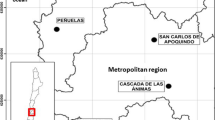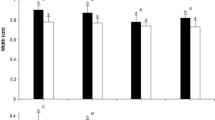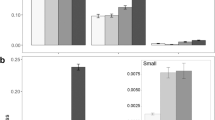Abstract
Several Opuntia spp. (Cactaceae) occur in large and dense stands in semiarid central Mexico. Their fruits and seeds are a major food source for rodents, and to a lesser extent, for harvester ants, birds, and other mammals. O. robusta and O. streptacantha differ in their timing of fruit production and presentation and in some fruit traits which may have different consequences for seed predation/dispersal interactions with the same group of animals. Multiple interactions suggesting a changing seed predation/seed dispersal facilitation among these plants and animals are reported. The fate of Opuntia seeds (either eaten or dispersed) after several possible seed predation/moving/dispersal interactions apparently depends on such characteristics of the habitat as the abundance of rodent populations and the availability of optional resources for these specialized granivores.
Access this chapter
Tax calculation will be finalised at checkout
Purchases are for personal use only
Preview
Unable to display preview. Download preview PDF.
Similar content being viewed by others

Literature cited
Andrews, R.S. and E.K. Bogess. 1978. Ecology of coyotes in Iowa. In: Coyotes: Biology, Behavior and Management (ed. M. Bekoff), pp. 249–264. Academic Press, New York.
Beattie, A.J. 1983. Distribution of ant-dispersed plants. Sonderbd. naturwiss. Ver. Hamburg 7: 249–270.
Beattie, A.J. and D.C. Culver. 1981. The guild of myrmecochores in the herbaceous flora of West Virginia forests. Ecology 62: 107–115.
Berg, R.Y. 1975. Myrmecochorous plants in Australia and their dispersal by ants. Aust. J. Bot. 23: 475–508.
Berg, W.E. and R.A. Chesness. 1978. Ecology of coyote in northern Minnesota. In: Coyotes: Biology, Behavior and Management (ed. M. Bekoff), pp. 265–286. Academic Press, New York.
Bissonette, J.A. 1982. Ecology and social behavior of the collared peccary in Big Bend National Park, Texas. Scientific Monograph Series No. 16, U.S. Department of the Interior, National Park Service, Washington.
Bravo-Hollis, H. 1978. Las Cactáceas de México. Universidad Nacional Autónoma de México, México, Distrito Federal.
Briese, D.T. 1982. Relationship between the seed-harvesting ants and the plant community in a semi-arid environment. In: Ant-Plant Interactions in Australia (ed. R.C. Buckley), pp, 11–24. Dr. W. Junk Publishers, The Hague.
Brown, J.H. and G.A. Lieberman. 1973. Resource utilization and coexistence of seed eating desert rodents in sand dune habitats. Ecology 54: 788–797.
Brown, J.H., O.J. Reichman and D.W. Davidson. 1979. Granivory in desert ecosystems. Ann. Rev. Ecol. Syst. 10: 201–227.
Buckley, R.C. 1982. Ant-plant interactions: A world review. In: Ant-Plant Interactions in Australia (ed. R.C. Buckley), pp. 111–142. Dr. W. Junk Publishers, The Hague.
Colunga-García-Marín, S.P. 1984. Variación morfológica, manejo agrícola y grados de domesticaciãn de Opuntia spp. en el Bajío Guanajuatense. M. Sc. Thesis, Colegio de Postgraduados, Chapingo, México.
Cox, G.W. 1980. Laboratory Manual of General Ecology. W.C. Brown Co. Publ., Dubuque, Iowa.
Davidson, E.A. 1982. Seed utilization by harvester ants. In: Ant-Plant Interactions in Australia (ed. R.C. Buckley), pp. 1–20. Dr. W. Junk Publishers, The Hague.
Davidson, D.W. and S.R. Morton. 1984. Dispersal adaptations of some Acacia species in the Australian arid zone. Ecology 65: 1038–1051.
Davidson, D.W., D.A. Samson and R.S. Inouye. 1985. Granivory in the Chihuahuan Desert: interactions within and between trophic levels. Ecology 66: 486–502.
Delgado, A.A. 1985. Caracterización de algunos componentes quimicos en frutos (‘tunas’) de nopal (Opuntia spp.) tunero en el Altiplano Potosino-Zacatecano. B. Sc. Thesis, Universidad Veracruzana, Orizaba, Veracruz.
Fogden, P., M. Fogden and J.M. Piña. 1978. Control, manejo y aprovechamiento de la fauna silvestre de los pastizales. Pastizales 9: 2–16.
García-Sánchez, R. 1984. Patrones de polinización y fenología floral en poblaciones de Opuntia spp. en San Luis Potosí y Zacatecas. B. Sc. Thesis, Escuela Nacional de Estudios Profesionales-Zaragoza, Universidad Nacional Autónoma de México, México, Distrito Federal.
Glendening, G.E. 1952. Quantitative data on the increase of mesquite and cactus on desert grassland range in southern Arizona. Ecology 33: 319–328.
Glyphis, J.P., S. J. Milton and W.R. Siegfried. 1981. Dispersal of Acacia cyclops by birds. Oecologia 48: 138–141.
González-Espinosa, M. 1982. Seed predation by desert harvester ants and rodents in central Mexico. Ph. D. Thesis, University of Pennsylvania, Philadelphia.
Grant, B.R. and P.R. Grant. 1981. Exploitation of Opuntia cactus by birds on the Galápagos. Oecologia 49: 179–187.
Hall, R.E. and K.R. Kelson. 1959. The Mammals of North America. Ronald Press, New York.
Herrera, C.M. 1982a. Defense of ripe fruit from pests: its significance in relation to plant-disperser interactions. Am. Nat. 120: 218–241.
Herrera, C.M. 1982b. Seasonal variation in the quality of fruits and diffuse coevolution between plant and avian dispersers. Ecology 63: 773–785.
Herrera, C.M. 1984. A study of avian frugivores, bird-dispersed plants, and their interaction in Mediterranean scrublands. Ecol. Monogr. 54: 1–23.
Holbrook, S.J. 1979. Habitat utilization, competitive interactions, and coexistence of three species of cricetine rodents in east-central Arizona. Ecology 60: 758–769.
Howe, H.F. and J. Smallwood. 1982. Ecology of seed dispersal. Ann. Rev. Ecol. Syst. 13: 201–228.
Howe, H.F. and G.E. Estabrook. 1977. On intraspecific competition for avian dispersers in tropical trees. Am. Nat. 1ll: 817–832.
Howe, H.F. and D. De Steven. 1979. Fruit production, migrant bird visitation, and seed dispersal of Guarea glabra in Panama. Oecologia 39: 185–196.
Hutto, R.L. 1978. A mechanism for resource allocation among sympatric heteromyid rodent species. Oecologia 33: 115–126.
Inouye, R.S., G.S. Byers and J.H. Brown. 1980. Effects of predation and competition on survivorship, fecundity, and community structure of desert annuals. Ecology 61: 1344–1351.
Janson, C.H. 1983. Adaptation of fruit morphology to dispersal agents in a neotropical forest. Science 219: 187–189.
Janzen, D.H. 1969. Seed-eaters versus seed size, number, toxicity and dispersal. Evolution 23: 1–27.
Janzen, D.H. 1971. Seed predation by animals. Ann. Rev. Ecol. Syst. 2: 465–492.
Janzen, D.H. 1981a. Guanacaste tree seed-swallowing by Costa Rican range horses. Ecology 62: 587–591.
Janzen, D.H. 1981b. Enterolobium cyclocarpum seed passage rate and survival in horses, Costa Rican Pleistocene seed dispersal agents. Ecology 62: 593–601.
Janzen, D.H. 1981c. Digestive seed predation by a Costa Rican Baird’s Tapir. Biotropica 13 (Suppl.): 59–63.
Janzen, D.H. 1982a. Removal of seeds from horse dung by tropical rodents: influence of habitat and amount of dung. Ecology 63: 1887–1900.
Janzen, D.H. 1982b. Attraction of Liomys mice to horse dung and the extinction of this response. Anim. Behav. 30: 483–489.
Janzen, D.H. 1982c. Differential seed survival and passage rates in cows and horses, surrogate Pleistocene dispersal agents. Oikos 38: 150–156.
Janzen, D.H. 1983. Dispersal of seeds by vertebrate guts. In: Coevolution (eds. D.J. Futuyma and M. Slatkin), pp. 232–262. Sinauer Associates Inc. Publishers, Sunderland, Massachusetts.
Janzen, D.H. 1984. Dispersal of small seeds by big herbivores: foliage is the fruit. Am. Nat. 123: 338–353.
Janzen, D.H. 1985. Chihuahuan Desert nopaleras: defaunated big mammal vegetation. In: Biogeography of Mesoamerica, Symposium, Mérida, Yucatán, México. In press.
Janzen, D.H. and P.S. Martin. 1982. Neotropical anachronisms: the fruits the gomphotheres ate. Science 215: 19–27.
Lakshminarayana, S. and B. Estrella. 1978. Postharvest respiratory behavior of tuna (prickly pear) fruit (Opuntia robusta Mill.). J. Hort. Sci. 53: 327–330.
McAdoo, J.K. and J. A. Young. 1980. Jackrabbits. Rangelands 2: 135–138.
McAdoo, J.K., C.C. Evans, B.A. Roundy, J.A. Young and R.A. Evans]. 1983. Influence of heteromyid rodents on Oryzopsis hymenoides germination. J. Range Manage. 36: 61–64.
McAtee, W.L. 1947. Distribution of seeds by birds. Am. Midl. Nat. 38: 214–223.
McKey, D. 1975. The ecology of coevolved seed dispersal systems. In: Coevolution of Animals and Plants (eds. L.E. Gilbert and P.H. Raven), pp. 159–191. University of Texas Press, Austin.
M’Closkey, R.T. 1980. Spatial patterns in sizes of seeds collected by four species of heteromyid rodents. Ecology 61: 486–489.
Millington, S.J. and P.R. Grant. 1983. Feeding ecology and territoriality of the Cactus Finch Geospiza scandens on Islas Galápagos. Oecologia 58: 76–83.
Miranda, F. and E. Hernández-Xolocotzi. 1963. Los tipos devegetación de México y su clasificación. Bol. Soc. Méx. 28: 29–179.
O’Dowd, D.J. and M.E. Hay. 1980. Mutualism between harvester ants and a desert ephemeral: seed escape from rodents. Ecology 61: 531–540.
Peterson, R.T. and E.L. Chalif. 1973. A Field Guide to Mexican Birds. Houghton-Mifflin, Boston.
Price, M. V. and N. M. Waser. 1985. Microhabitat use by heteromyid rodents: effects of artificial seed patches. Ecology 66: 211–219.
Pulliam, H.R. and M.R. Brand. 1975. The production and utilization of seeds in plains grassland of southeastern Arizona. Ecology 56: 1158–1166.
Quintana-Ascencio, P.F. 1985. Dispersión de las semillas de nopal (Opuntia spp.) por animales silvestres y domésticos en ‘El Gran Tunal’, San Luis Potosí. B. Sc. Thesis, Universidad Nacional Autónoma de México, México, Distrito Federal.
Racine, C.H. and J.F. Downhower. 1974. Vegetative and reproductive strategies of Opuntia (Cactaceae) in the Galapagos islands. Biotropica 6: 175–186.
Reichman, O.J. 1979. Desert granivore foraging and its impact on seed densities and distributions. Ecology 60: 1085–1092.
Reichman, O.J. and D. Oberstein. 1977. Selection of seed distribution types by Dipodomys merriami and Perognathus amplus. Ecology 58: 636–643.
Reynolds, H.G. 1950. Relation of Merriam Kangaroo Rats to range vegetation in southern Arizona. Ecology 31: 456–463.
Reynolds, H.G. 1958. The ecology of the Merriam Kangaroo Rat (Dipodomys merriami Mearns) on the grazing lands of southern Arizona. Ecol. Monogr. 28: 111–127.
Rivas-Manzano, I.V. 1984. Estudios experimentales sobre la sucesión en agostaderos de ‘El Gran Tunal’, San Luis Potosí. B. Sc. Thesis, Escuela Nacional de Estudios Profesionales-Zaragoza, Universidad Nacional Autónoma de México, México, Distrito Federal.
Rodríquez-Zapata, O.1981. Fenología reproductiva y aporte de frutos y semillas en dos nopaleras del Altiplano Potosino-Zacatecano. B. Sc. Thesis, Universidad Autónoma de Nuevo León, Monterrey, Nuevo León, México.
Rosenzweig, M.L. 1973. Habitat selection experiments with a pair of coexisting heteromyid rodent species. Ecology 54: 111–117.
Rzedowski, J. 1966. Vegetación del estado de San Luis Potosí. Act. Cient. Potos. 5: 5–291.
Rzedowski, J. 1978. Vegetación de México. Limusa, México, Distrito Federal.
Rzedowski, J. and R. McVaugh. 1966. La vegetación de Nueva Galicia. Contr. Univ. Michigan Herb. 9: 1–123.
Santana-Sepúlveda, L.E. 1981. Actividad de forrajeo de hormigas recolectoras Pogonomyrmex spp. y la disponibilidad de recursos en nopaleras de San Luis Potosí y Zacatecas. B. Sc. Thesis, Universidad Michoacana de San Nicolas de Hidalgo, Morelia, Michoacán, México.
Snow, D.W. 1965. A possible selective factor in the evolution of fruiting seasons in tropical forest. Oikos 15: 274–281.
Snow, D.W. 1971. Evolutionary aspects of fruit eating by birds. Ibis 113: 194–202.
Snow, D.W. 1981. Tropical frugivorous birds and their food plants: A world survey. Biotropica 13: 1–14.
Sowls, L.K. 1974. Social behaviour of the Collared Peccary Dicotyles tajacu L. In: The Behaviour of Ungulates and its Relation to Management (eds. V. Geist and F. Walther), 1: 144–165. IUCN New Series, Publication 24, Morges, Switzerland.
Siegel, S. 1956. Nonparametric Statistics for the Behavioral Sciences. McGraw-Hill, New York.
Spencer, D.A. and A.L. Spencer. 1941. Food habits of the White Throated Wood Rat in Arizona. J. Mammal. 22: 280–284.
Tappe, D.A. 1941. Natural history of the Tulare Kangaroo Rat. J. Mammal. 22: 117–148.
Trombulak, S.C. and G.J. Kenagy. 1980. Effects of seed distribution and competitors on seed harvesting efficiency in heteromyid rodents. Oecologia 44: 342–346.
Whitford, W.G., P. Johnson and J. Ramirez. 1976. Comparative ecology of the harvester ants Pogonomyrmex barbatus (F. Smith) and Pogonomyrmex rugosus (Emery). Insectes Soc. 23: 117–132.
Walker, E.P. 1975. Mammals of the World. The Johns Hopkins University Press, Baltimore, Maryland.
Wicklow, D.T., R. Kumar and J.E. Lloyd. 1984. Germination of Blue Grama seeds buried by Dung Beetles (Coleoptera: Scarabaeidae). Environ. Entomol. 13: 878–881.
Willson, M.F. and J.N. Thompson. 1982. Phenology and ecology of color in bird-dispersed fruits, or why some fruits are red when they are ‘green.’ Can. J. Bot. 60: 701–713.
Zervanos, S.M. and N.F. Handley. 1973. Adaptational biology and energy relationships of the Collared Peccary (Tayassu tajacu). Ecology 54: 759–773.
Author information
Authors and Affiliations
Editor information
Rights and permissions
Copyright information
© 1986 Dr W. Junk Publishers, Dordrecht
About this chapter
Cite this chapter
González-Espinosa, M., Quintana-Ascencio, P.F. (1986). Seed predation and dispersal in a dominant desert plant: Opuntia, ants, birds, and mammals. In: Estrada, A., Fleming, T.H. (eds) Frugivores and seed dispersal. Tasks for vegetation science, vol 15. Springer, Dordrecht. https://doi.org/10.1007/978-94-009-4812-9_24
Download citation
DOI: https://doi.org/10.1007/978-94-009-4812-9_24
Publisher Name: Springer, Dordrecht
Print ISBN: 978-94-010-8633-2
Online ISBN: 978-94-009-4812-9
eBook Packages: Springer Book Archive



